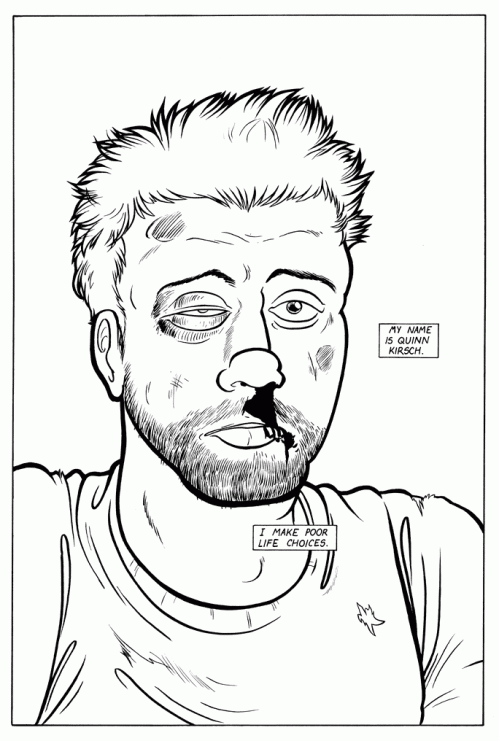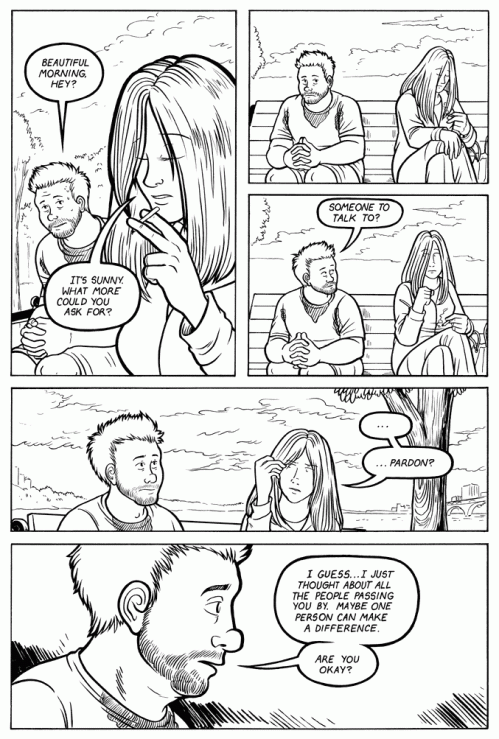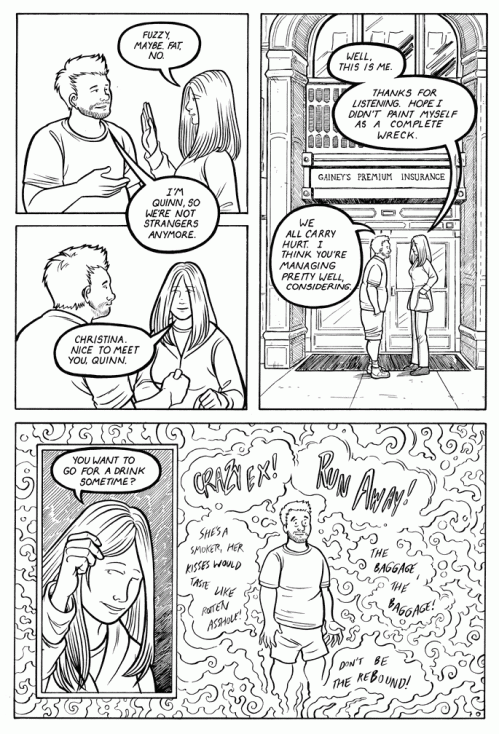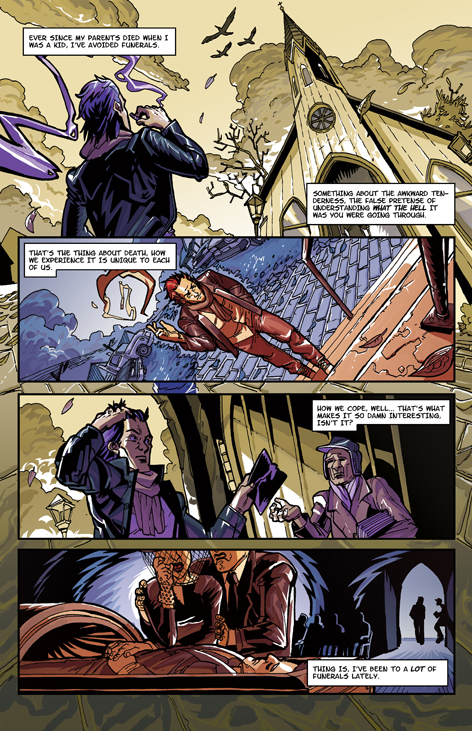The Mythology of Green Wake
So, this is it. The final day of a series I’m very proud to have worked on with my amazing co-creator, Riley Rossmo. Read all about the mythology of our series below. Once you’ve done that, head over to http://forums.imagecomics.com/viewtopic.php?f=43&t=1324 for a live discussion of the series and to have any further questions answered.
THE CONTEST:
First person to post a picture of themselves holding a Green Wake #1 single (first printing) in the discussion thread linked above will receive the Green Wake Volume #1 TPB signed by me in the mail.
Now, on with the show!
Green Wake Explained
The Origin
The history of Green Wake goes back to the earliest part of civilization. In Issue #7, we hinted that Ishum was somehow involved with the origin of the town itself, and though never implicitly explained, pointed to the arrival of some powerful being that tricked him and his people in some way.
Let me explain, first, what the sequence means.

Panel 1: Ishum was a simple fisherman that lived in the area of Egypt around 8,000 BC.
Panel 2: One day he is approached by a mysterious woman, a beautiful goddess of immense power. Smitten by her, Ishum leads her back to his village.
Panel 3: In a display of her power she spews forth the Nile from her mouth and is immediately worshipped by the people who bore witness to the event. They called her Hecate, a goddess of fertility and resurrection.
Panel 4: After a time, Ishum fell in love with Hecate and their bond grew.
Panel 5: Hecate shared a vision with Ishum of a beautiful new world they could inhabit together, a world without death. They could live together forever, if only Ishum could convince his fellow people to join them.
Panel 6: The villagers believed in Hecate and willingly entered into this new world where death could no longer claim them.
Panel 7: But Hecate was not benevolent, she had tricked Ishum and his people. Despite her treachery, Hecate cared for Ishum, the man who made this world possible and filled it with life. She took his eyes so that he would never see the suffering of his people.
Panel 8: Trapping the villagers inside her world, Hecate stepped outside and left the people to wallow in their misery, cut off from the goddess who had given them hope and immortality.
Panel 9: With a whole world resting in her hands-
Panel 10: Hecate devoured and siphoned the life from it, feeding on its energy to stay alive forever.
Hecate
So, who was this all powerful monster that the villagers called Hecate? Was she a goddess of immense power, a woman who watched the world below from the heavens?
Hecate is not a man or a woman, but perhaps a being equal to what humanity would consider a god. It is a monster, a cosmic leech that gains power and life from the psychic energy of human beings. While given no physical form, this nameless monster can infect the mind and take shape through hallucinations. This is how Ishum was seduced.
Green Wake
The villagers never entered Green Wake with their physical bodies. It was only a machination of their mind, created with the aid of the monster but mostly by their own willpower. Hecate planted the seed of what their world could be, the promise and hope they would find on the other side. They never walked from one world to the next, rather, Hecate pulled each of them in through their subconscious mind. It is that part of the person that lives in Green Wake.
We deal a lot with the concept of the collective subconscious through the series but the focus was always on guilt and suffering. When Ishum realized he led his people into a trap, he guilt became all encompassing. Hecate realized that loss and sadness were powerful emotions, much more satisfying and filling than those of happiness and hope. The town of Green Wake slowly changed over time, encouraged by the subtle nudge of Hecate, small reminders of painful memories that would surface within the streets and rivers.
The Flow of Time
We introduced numerous characters, all from different timelines. This was tied into the concept of the collective subconscious but I chose to take that idea and spread it throughout history. Green Wake existed outside of time and reality as we knew it, it drew in the lost, broken and sorrowed from all over the world, from all over time.
Krieger arrived before Morley but his story of loss began almost 10 years after the death of Anna. Carl and Ariel were from a modern timeline and The Senator, well, he was Brutus from Julius Caesar. There isn’t a solid answer on why I chose to make that part of the story other than it was a fun narrative device and added to the alien feel of the town.
The Metaphor
I’ve been up front that Green Wake is a huge metaphor for how I view guilt and sadness. When I first started writing the idea of Green Wake, I was in the middle of a painful relationship with a partner that had a lot of hurt in their life. For a long time I took that wound on myself, as though it was my responsibility to help her get better or to carry that burden so she wouldn’t have to. I carried that for a long time and it was those feelings that eventually became the metaphor in Green Wake.
We run from our hurt. It’s the natural thing to do, why face the hardest moments in our lives when we can just push them away and find something new or someone better? We carry on as though that past life no longer has any hold on us, but unless we face those demons, we are changed by those experiences. Sometimes it’s a slow descent, sometimes we come apart at the seams faster than we could ever hope to recover from it.
In the narrative, Green Wake is the place those memories and thoughts go to hide. It is the part of us that cannot deal with whatever event it was that changed us or hurt us so deep we can’t even imagine forgiving ourselves for it.
Hecate, the power behind Green Wake, used those memories to control the people who lived there, to let that part of the person wallow in misery as a means to stay fed. Little reminders that kept her residents off the path of recovery.
The longer a person stayed hidden in their guilt, or, a citizen of Green Wake, the more it changed them. Which leads me to-
What the Hell is up with all the Frogs?
This was a question I got over and over again and I think a lot of people thought it was just a visual gimmick. There was a small amount of truth to that, but the meaning goes a lot deeper. This ties into my original reason for writing Green Wake; a failed marriage. I spent a lot of time reflecting about my life as I began fleshing out the world and one theme I kept coming back to was how much I’d changed in my twenties. When I was living it, at the time, I couldn’t see one step ahead of myself but now that I was finally able to gain some perspective, I was able to step outside my life and see it for what it really was.
I saw patterns in my life and I saw patterns in my partners’. It was a pattern of negligence. Negligence to address real issues, to tackle our hurt and work together on resolution. The longer we avoided the reality of our past hurt and sadness, the more it changed us. We used to be happy, to a certain extent, but by the end our attitude towards each other was venomous. How did that happen?
The frogs are the result of what happens when people avoid facing their demons. In the world of Green Wake, the longer they stayed the more Hecate took from them and their change took an outwardly physical toll. That’s why some people looked more froglike than others, they were content to just fade away in the borders of the forgotten town rather than question how and why they got there.
Then, of course, there were thousands of ACTUAL frogs, and they, too, were once people. So drained, so far gone, so completely taken by their guilt and sorrow they’d become consumed by it. There was no hope for those people to ever come back to reason.
Babylon
It was never a physical place to find. Babylon was redemption and forgiveness. The only way one could ever escape Green Wake was to face the pain and deal with it, and, eventually come to the understanding that you can overcome grief and loss.
The Real World
Everyone that exists in Green Wake lives in the real world. It is their subconscious mind that carries on life in the creepy town, not their actual body. While the events of the series predominantly take place in Green Wake, there are sequences that take place in the real world. In the first volume, they are all coloured in Sepia. While trying to uncover the mystery of Ariel in Green Wake, Morley is dealing with the loss of his wife and the fear of facing her at the funeral in the real world. It is the same for all the characters in the series, but there’s a special sequence that involves Carl and Ariel.
The Murder of Ariel
Remember how Carl shows up in a boat right around the time Ariel goes insane? In issue #4, Ishum tells Ariel that she’s lost her tether; he is, of course, speaking about her physical body. Carl killed her in the real world shortly after she confessed to cheating on him. However, Ariel came to Green Wake because of the guilt she felt over cheating on Carl and so arrived shortly before him.
We took some liberties with our mythology because the murder affects Green Wake in a significant way.
1) It has happened before. The Senator says as much in his appearance in Issue #2, meaning that someone who lives in Green Wake has been killed in the real world which means they only exist as memories. They are, essentially, a ghost. An insane ghost.
2) The killer has felt remorse and guilt, pulling them onto Green Wake’s shore. Carl isn’t the first to arrive after murdering someone who already lives in town. There are others like him. The monsters that arrive in a burst of toads and water.
The Title
There were layers to the title of the series. First and foremost, it was the name of a town, a simple, vague and weird name that on an outward appearance means little. However, there were some themes present within. The colour green was a symbolic allusion to jealousy, which tied into Carl’s story, but also connected to what made Green Wake the town it was; loss, sadness and mourning. The second part of the title also had two meanings: a funeral, the death of happiness, the reason people ended up in the town. The other was straightforward; a place you would wake with no memory of how you got there.
Final Thoughts on the Series
I love Green Wake. I can say that with the sincerest of affections because not only was it a series that brought me new fans and friends, but because it was a story that allowed me to grieve and embrace a new chapter of my life. I still can’t read the end of Volume #1 without getting a lump in my throat because it is a verbal and visual expression of the death of my marriage. It is the most personal story I’ve ever written and I’m immensely proud of the series in a way I probably can never replicate.
But, you know, that’s O.K. because I’m in a wonderful place right now.
Many people have asked me if it was difficult to end the series early and I can say that while it was frustrating, it was also the right time. I love where my life is right now and I’m very happy to be moving on to projects where that enthusiasm and joy can bleed into the narrative.
I’ll always cherish this series; Green Wake was my quiet therapy for over a year. I became good friends with Riley Rossmo and shared some great stories over coffee about life, love and loss. And, just as important, I met new friends and made new fans, for which I’m very grateful. I cannot tell you how rewarding it is to have a total stranger come up to you and share that what you wrote spoke to them on a deeply personal level.
There is nothing like it.
So, I keep writing. I’m honest about who I am in the work I put out in the world and, if you’re paying attention, you’ll get to know me a little through the worlds and characters I breathe life into.
Thank you for the support you’ve shown this series, I hope you have enjoyed this journey as much as I have.
Happy reading, everyone.
Kurtis J. Wiebe













